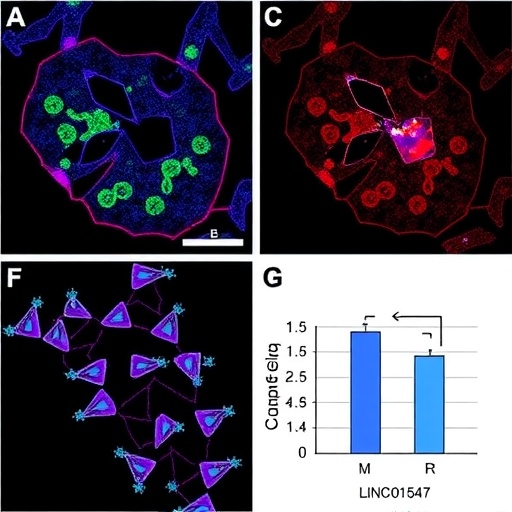In a groundbreaking study that delves into the molecular intricacies of pancreatic cancer, researchers Lu, Gong, and Chen, along with their collaborators, have unveiled significant insights into how m6A modification of a long non-coding RNA (lncRNA) called LINC01547 influences cancer growth and treatment resistance. The findings, published in “Biochemical Genetics,” reveal the underlying mechanisms of how LINC01547 contributes to pancreatic cancer progression and the emergence of gemcitabine resistance, a common chemotherapeutic agent used in treatment.
Pancreatic cancer is one of the deadliest forms of malignancy, characterized by its late diagnosis and poor prognosis. The complexity of this disease has driven researchers to explore innovative biomarkers and therapeutic targets. The new research highlights the critical role of epitranscriptomics—the study of RNA modifications—in understanding cancer biology. Among various modifications, N6-methyladenosine (m6A) has emerged as a pivotal player, influencing RNA stability, translation, and decay.
Central to this research is LINC01547, a lncRNA whose expression is found to be elevated in pancreatic cancer tissues. The team conducted a series of experiments demonstrating that higher levels of LINC01547 correlate with increased tumor growth and a worse response to chemotherapy. By establishing a connection between LINC01547 and m6A modification, the authors further elucidate how this modification may enhance the lncRNA’s stability and functional capacity in cancer cells.
Through in vitro and in vivo studies, the researchers demonstrated that silencing LINC01547 led to significant reductions in pancreatic cancer cell proliferation and invasion. These observations underscore the potential of targeting lncRNAs as a therapeutic approach. The study also highlights the therapeutic implications of restoring normal levels of LINC01547 activity, which could modify cancer cell behavior and enhance sensitivity to chemotherapeutic agents.
The mechanism of action delineated in the study implicates the miR-34a-5p/MYH9 axis as a crucial pathway through which LINC01547 exerts its effects. MiR-34a-5p is known for its tumor-suppressive functions in various cancers, including pancreatic malignancies. The research reveals that LINC01547 interferes with the regulatory activities of miR-34a-5p, consequently leading to the upregulation of MYH9, a gene associated with enhanced oncogenic capacities. This intricate relationship sets the stage for potential targeted therapies that could disrupt this harmful interaction.
In a further exploration of the clinical implications, the authors discussed how the findings could inform prognostic assessments. Elevated levels of LINC01547 could serve as a biomarker for predicting which pancreatic cancer patients are likely to develop resistance to gemcitabine. Based on this knowledge, clinicians may be able to personalize treatment strategies, sparing patients from ineffective therapies and guiding them toward more effective options.
The study’s innovative approach integrates molecular biology techniques with a clinical perspective, suggesting that targeting LINC01547 might not only enhance therapeutic efficacy but may also lead to the development of novel RNA-based therapies. These therapies could exploit the vulnerabilities identified in the study, specifically regarding the modulation of m6A levels and the miR-34a-5p/MYH9 axis.
Alongside its scientific contributions, this research emphasizes the critical need for continued investigation into the roles of lncRNAs and RNA modifications in cancer. As our understanding of the cancer transcriptome evolves, it becomes increasingly clear that the interplay between genetic and epitranscriptomic factors offers a promising avenue for therapeutic intervention.
The ramifications of this research extend beyond pancreatic cancer, as the principles of m6A modification and lncRNA function may apply to a wider array of malignancies. The burgeoning field of RNA biology is likely to uncover further connections that may reshape our understanding of cancer and lead to new therapeutic innovations.
The implications for future research are profound. As researchers delve deeper into the multi-layered interactions between lncRNAs, RNA modifications, and signaling pathways, they unveil new layers of complexity in cancer biology. The potential development of RNA-based therapeutics holds promise, offering hope for patients grappling with resistant forms of cancer.
As the scientific community continues to unravel the complexities of cellular mechanisms, the findings from this study provide a solid foundation from which to explore new diagnostic and treatment paradigms for pancreatic cancer and beyond. With increasing focus on personalized medicine, insights into RNA modifications could lead to more precise and effective therapies that cater to the unique profiles of individual tumors.
In summary, Lu, Gong, and Chen’s study represents a significant advance in our understanding of pancreatic cancer biology through the lens of m6A modification. Their exploration of LINC01547 not only uncovers the details of how this lncRNA promotes cancer growth and treatment resistance but also challenges us to rethink strategies for intervention in this challenging disease. This research is a testament to the power of molecular research in unveiling the hidden truths of cancer, paving the way for new hope in treatment strategies tailored to combat one of the most aggressive cancers known to date.
The path forward in pancreatic cancer research must emphasize the integration of molecular insights with clinical practice, as this fusion will maximize the potential for novel therapeutic development and improved patient outcomes.
Subject of Research: Pancreatic cancer and the role of LINC01547 in m6A modification
Article Title: m6A Modification-Mediated LINC01547 Promotes Pancreatic Cancer Growth and Gemcitabine Resistance Through miR-34a-5p/MYH9 Axis
Article References:
Lu, G., Gong, J., Chen, Y. et al. m6A Modification-Mediated LINC01547 Promotes Pancreatic Cancer Growth and Gemcitabine Resistance Through miR-34a-5p/MYH9 Axis. Biochem Genet (2025). https://doi.org/10.1007/s10528-025-11254-5
Image Credits: AI Generated
DOI: 10.1007/s10528-025-11254-5
Keywords: Pancreatic cancer, LINC01547, m6A modification, gemcitabine resistance, miR-34a-5p, MYH9, long non-coding RNA, epitranscriptomics.
Tags: biomarkers for pancreatic cancerepitranscriptomics and cancer biologygemcitabine resistance mechanismslate diagnosis of pancreatic malignancyLINC01547 in pancreatic cancerlong non-coding RNA and chemoresistancem6A modification in cancer researchmolecular mechanisms of cancer treatment resistancenovel therapeutic targets in oncologypancreatic cancer progression insightsRNA modifications in tumor responsetumor growth and RNA stability





